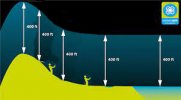I just bought a used Mini 2. Here's my question:
If I take off from a cliff or some other high point and the altitude is, let's say, 10'. Then I proceed forward off the, let's say, 200' high cliff. What would the altitude reading be? 10' or 210'
I can see where this would make a difference regarding the 400' ceiling law.
Thanks
Ponz
If I take off from a cliff or some other high point and the altitude is, let's say, 10'. Then I proceed forward off the, let's say, 200' high cliff. What would the altitude reading be? 10' or 210'
I can see where this would make a difference regarding the 400' ceiling law.
Thanks
Ponz











